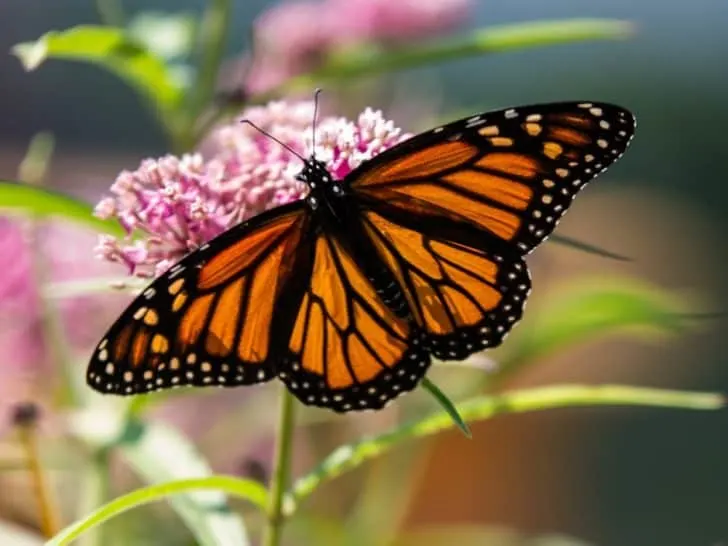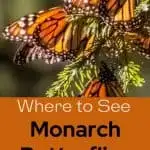Monarch butterflies that live west of the Rocky Mountains migrate into Mexico and California during the winter months. From north to south, here are some of the best places to see monarch butterflies in California.
These “over-wintering sites” tend to be home to thousands upon thousands of individual butterflies from early November through late February.
Quick Facts about Monarch Butterflies
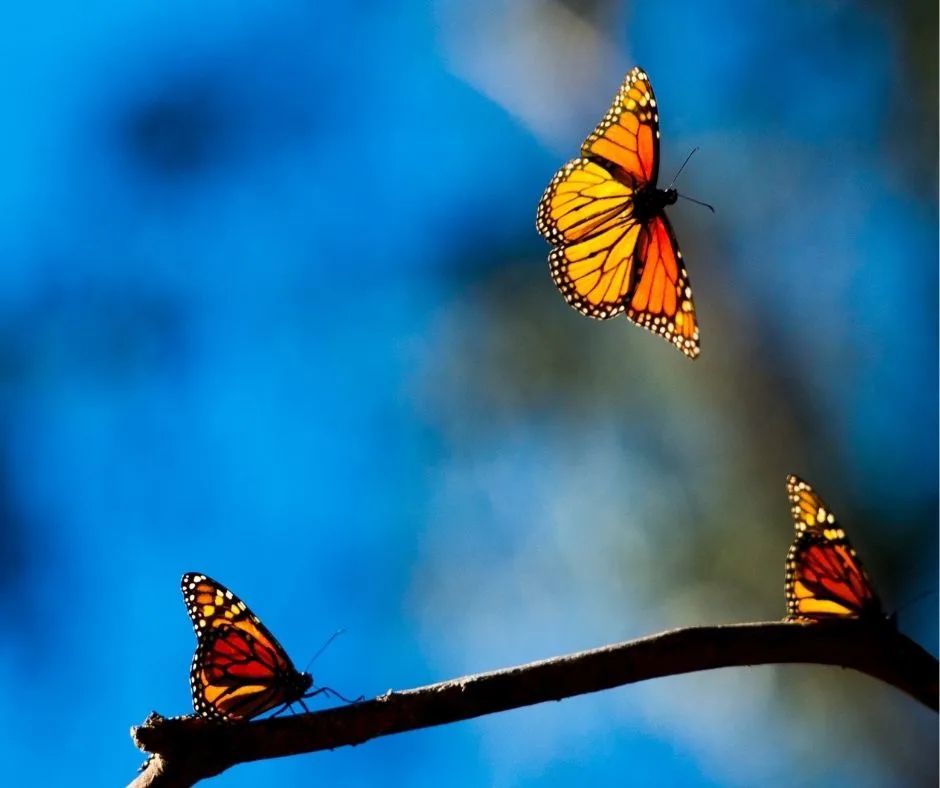
Facts & information gathered from personal museum visits and the National Geographic Kids website on Monarch butterflies.
- Monarch butterflies live all over the world, although the migrating species we see in the United States stay mostly in Mexico, the U.S., and Canada.
- Milkweed is the only plant that monarch butterflies lay their eggs on. This plant is necessary for the butterfly’s survival, and is being depleted by over-farming and industrialization throughout North America.
- North American monarch butterflies migrate south for the winter. Sometimes this journey is over 2,800 miles.
- All North American monarchs travel to Mexico or California for the winter, even though the individual butterflies have never been there before (monarchs live less than one year!).
- Not officially yet an “endangered species,” the monarch butterfly is “Near Threatened” according to the World Wildlife Fund. This is due to many factors including climate change, habitat loss due to deforestation, and herbicide killing off food sources.
- The western migratory monarch butterfly population has dropped 99% since the 1980s.
- 45% of Western Monarch Butterflies overwinter in California State Parks.
The Best Places to See Monarch Butterflies in California
Best Places to See Monarch Butterflies Near San Francisco
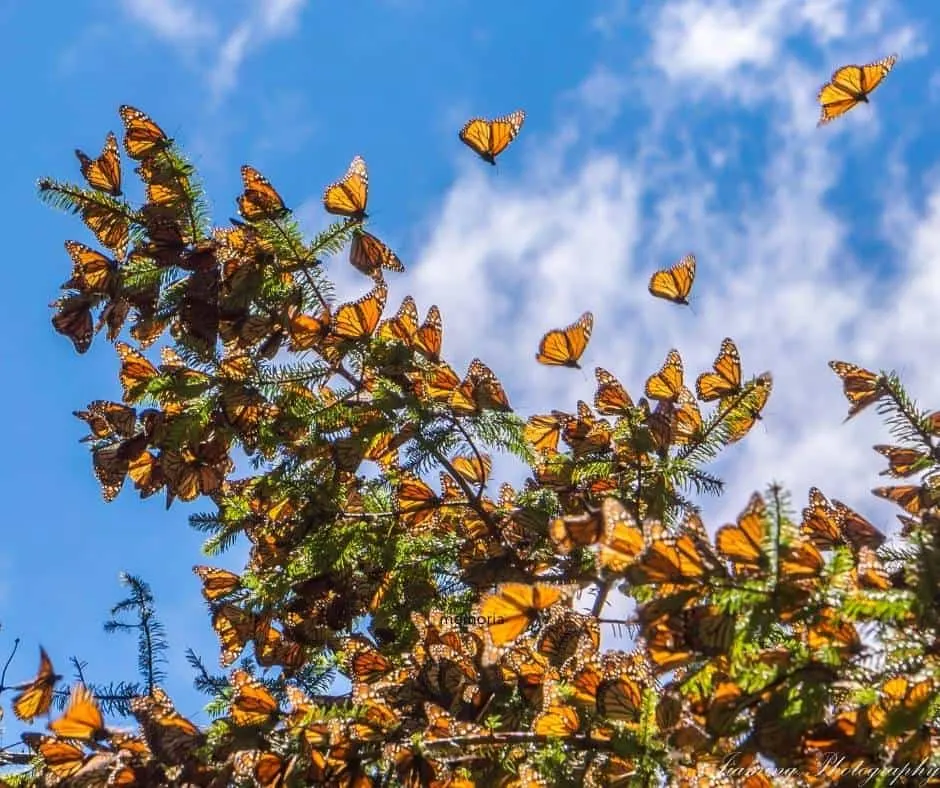
Bodega Head
Monarchs will occasionally migrate as far north as San Francisco, although most tend to stay slightly south of the San Francisco Peninsula.
One exception to that seems to be Bodega Head, a little over an hour north of the city. Families staying at Bodega Dunes Campground can find them roosting in the trees or along the shoreline.
Arenwood Historic Farm
Just north of San Jose, along the eastern shore of the San Francisco Bay, Ardenwood is one of the northernmost winter homes for monarch butterflies, and one of the very few not directly on the coast.
If you don’t happen to see a ton of butterflies here, kids will surely enjoy the farm animals, trains, and old-fashioned fun offered onsite, making this stop a win win.
Best Places to See Monarch Butterflies Near Monterey Bay
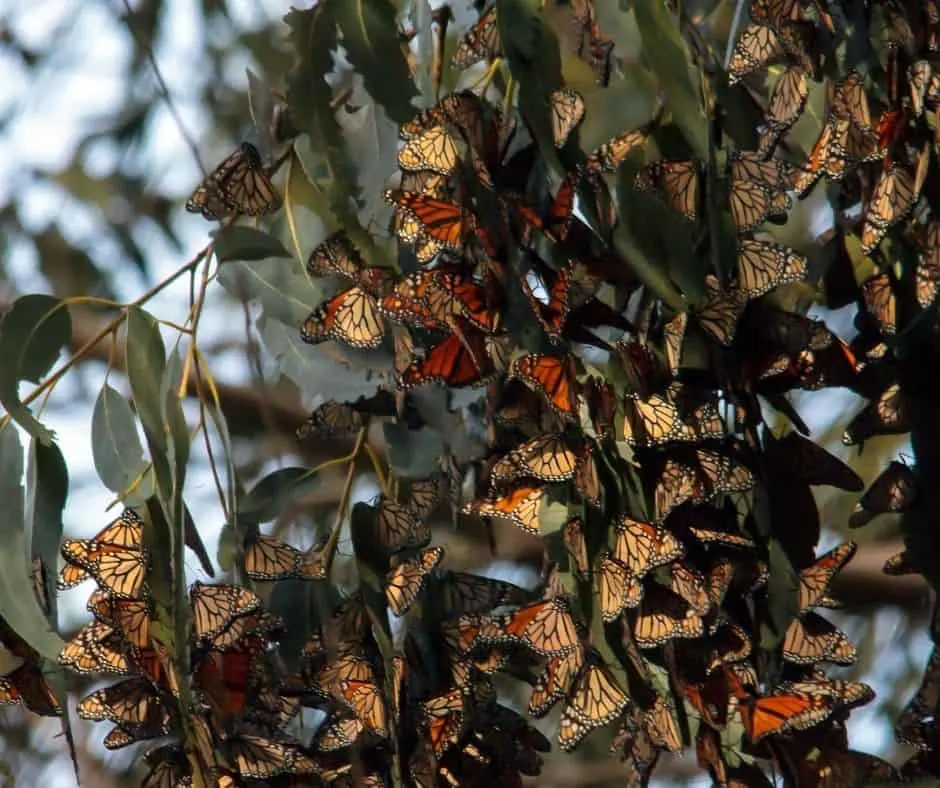
Natural Bridges State Beach
Natural Bridges State Beach in Santa Cruz is the only State Monarch Preserve in California. In 2021, Natural Bridges State Beach held the largest number of overwintering western monarchs, comprising 28% of the total population!
Visitors to this state park can take guided tours from docent naturalists weekends from mid-October through mid-January to see the migrating families of monarchs that roost in the tall Eucalyptus trees. Lighthouse Field State Beach is another Santa Cruz option.
Here are the top things to do in Santa Cruz with kids.
Pacific Grove
The Pacific Grove Museum of Natural History and nearby Monarch Butterfly Sanctuary offer great programs for visiting families.
At the museum, kids can learn about monarchs, study their migration, and receive free seed packets to plant a monarch-friendly garden at home. A visit to the Monarch Butterfly Sanctuary offers an easy stroll through tall Eucalyptus trees to view winter roosts.
Check out the 10 best things to do in Monterey with kids.
Point Lobos State Natural Reserve
Rangers & docents are available in season at Point Lobos State Natural Reserve to assist with finding butterfly roosts in this stunning Carmel location. This state park is also a great place to go for hike and view marine mammals like seals and otters.
Visiting Point Lobos is one of our favorite things to do outside in Monterey County.
Big Sur
Andrew Molera State Park (and campground) often features a small roosting group of monarchs during the winter. Public horseback riding tours often take visitors past these sites via the numerous trails in the state park and docents are available during the season.
Best Places to See Monarch Butterflies Near Morro Bay
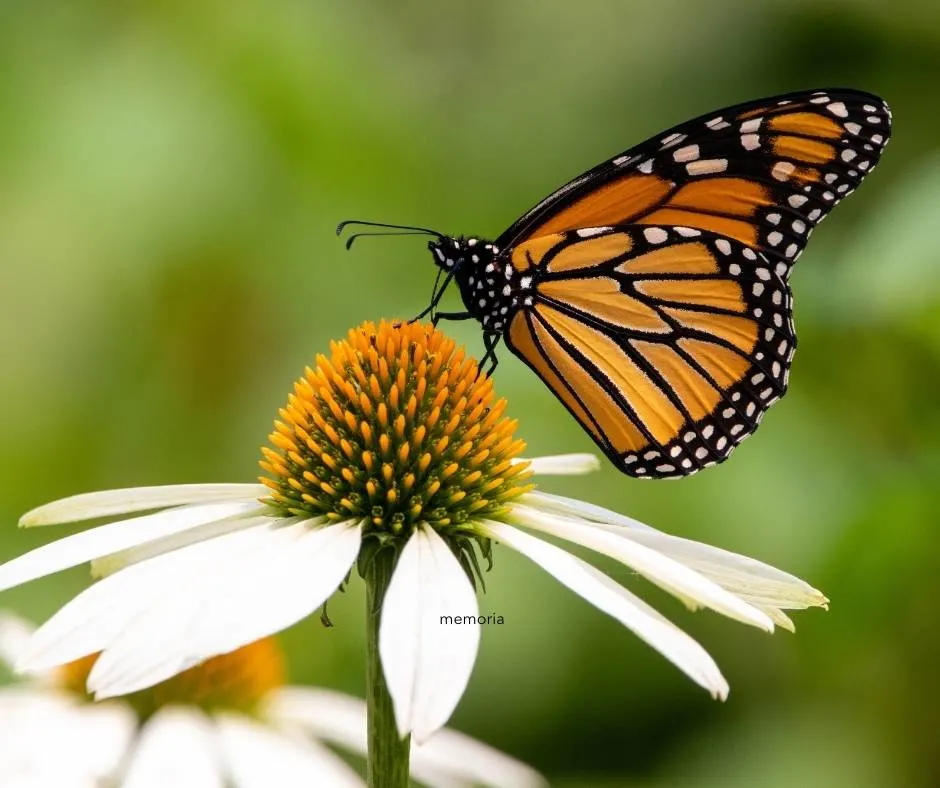
Morro Bay State Park
For families seeking to catch a glimpse at the roosts in the wild, visit Morro Bay State Park; Campsite #116 is host to its own Eucalyptus trees making it a great option for spotting these beauties from your RV or tent.
Discover our favorite things to do in Morro Bay on a family vacation.
Museum of Natural History
Morro Bay’s Museum of Natural History is a fantastic hub for learning about monarch butterflies while on vacation. Kids 17 and under are free and adults are just $3.
Pismo Nature Center & Monarch Grove
Part of Pismo State Beach, boasts one of the largest roosts in California, often with more than 25,000 monarchs per season.
Daily talks and docent tours are offered during the season at the Pismo Nature Center and Monarch Grove. The grove is adjacent to both the beach and Pismo’s North Beach Campground.
Best Places to See Monarch Butterflies Near Santa Barbara
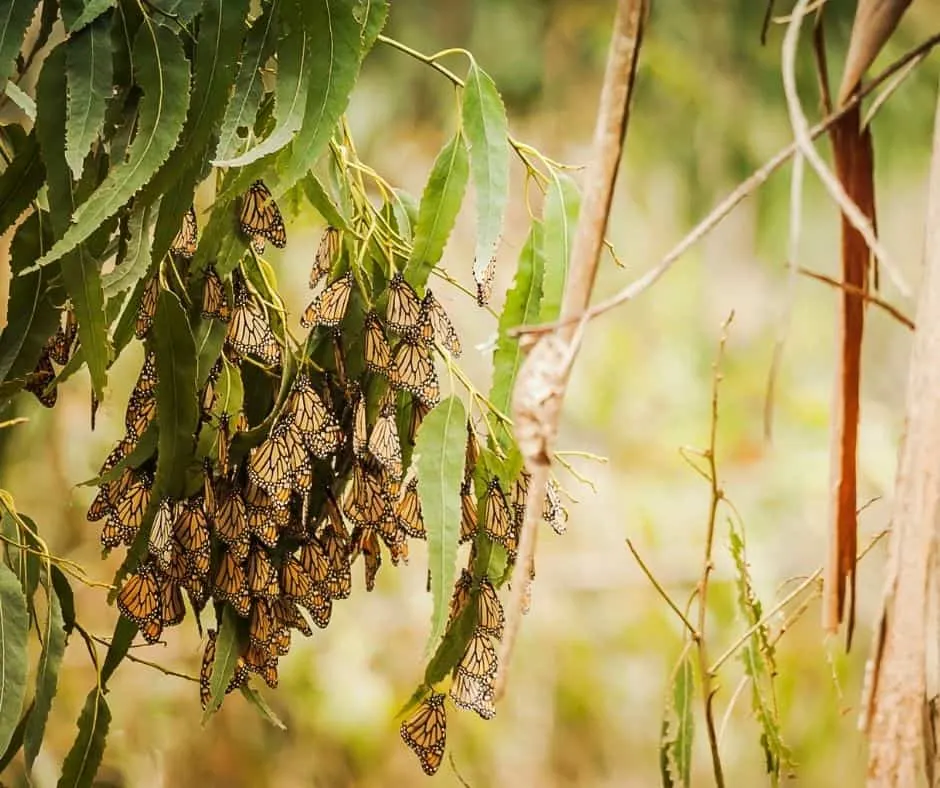
Goleta Monarch Butterfly Grove & Coronado Butterfly Preserve
With an average of over 50,000 individual butterflies per season, these two adjacent roosting sites, just north of Santa Barbara, are must-sees for visitors!
Free parking for both Goleta Monarch Butterfly Grove and Coronado Butterfly Preserve is available 1/2 mile away at the Sperling Preserve at Ellwood Mesa Open Space. Docents can be found on most weekends in season (November through February) from 11am – 2pm.
Best Places to See Monarch Butterflies in Southern California
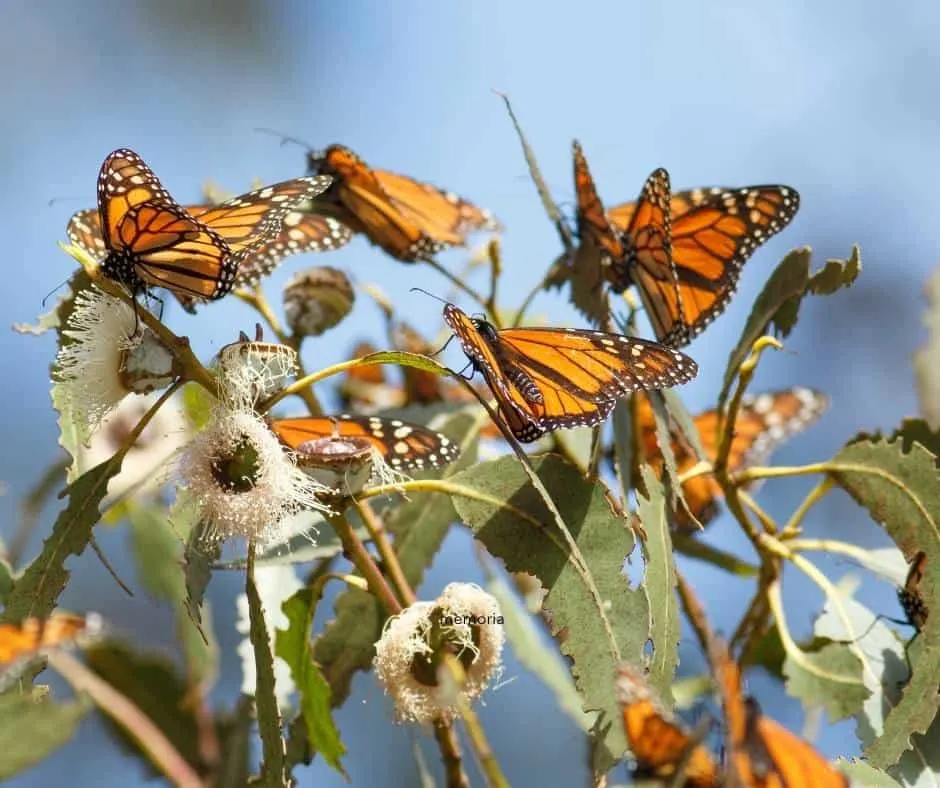
Point Mugu State Park
Point Mugu State Park, just northwest of Los Angeles, is a small autumn site for monarchs. There is also a nice beach and more than 70 miles of hiking trails at this state park.
El Dorado Nature Center
El Dorado Park is an expansive regional park in Long Beach. It can be a lot to tackle in search for monarch roosts. Ask at the visitor center for recent sightings.
Bonus: Visit the Mexico Over-Wintering Site
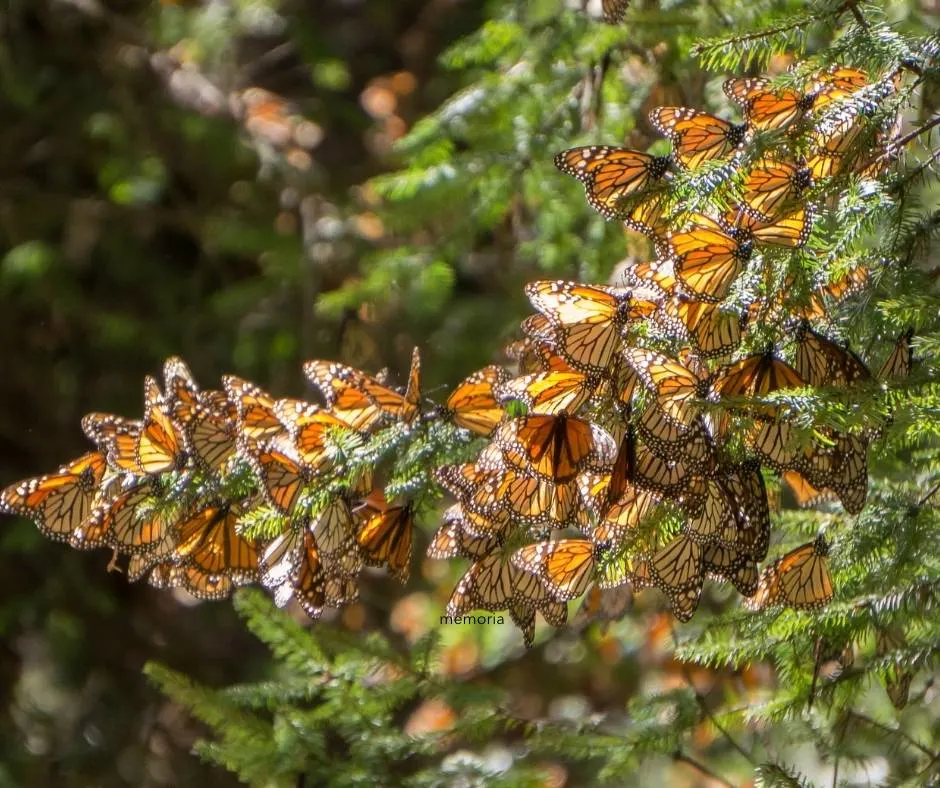
All monarch butterflies east of the Rocky Mountains head exclusively to Mexico in the winter. Specifically, as many as 60 million to one billion Monarchs hibernate in the Reserva de la Biosfera Mariposa Monarca in Michoacan, Mexico (Monarch Butterfly Biosphere Reserve), a national protected nature preserve.
It can be challenging to take young kids to this awe-inspiring sanctuary as the roosts are accessed via hike (often up to two miles of moderate to advanced hiking trails) at an elevation of over 10,000 feet. But families with older children and a passion for butterflies may find this to be a trip of a lifetime.
Not near California or Mexico? Check out these museums with fabulous exhibits on butterflies at large.
Feeling Inspired? What you can do to save Monarchs
Once your kids visit one of these best places to see Monarch butterflies in California or even watches the Flight of the Butterflies documentary film (highly recommend this!), they will likely want to know what they can do to help the monarch butterfly population.
And although you can’t stop climate change and global warming all on your own, there are a few things you can do to help the monarch butterfly.
- Plant milkweed. Herbicides and over farming have killed off a significant portion of North American milkweed, which is the only plant adult monarchs will lay eggs on. Planting milkweed at your home gives the species one more spot to land upon to reproduce.
- Plant nectar flowers for adult butterflies; they should be large enough flowers to support the weight of the butterfly. Great options include marigolds, cosmos, and asters.
- Adopt a Monarch butterfly through the World Wildlife Fund. Your donation will work towards conservation efforts including working with Mexico to stop illegal logging. Kids can choose an adorable gift for their donation, including gift bags, an adorable plush, adoption certificate, and more.
- “Join the Odyssey” works directly with the Mexican Fund for the Conservation of Nature to save butterflies, forests, and natural habitats in Mexico. A donation of just $5 can help save the Monarchs.

